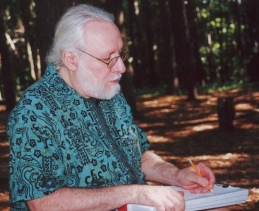
Why should I add my music and sounds to those in the woods?
Cities have parks. What are they for? Recreation. That is, re-creation, returning to the vast, the basic ground that we share with all other forms of life. But should we dichotomize "nature" with "civilization," or more mildly put, "country" and "city" life? Certainly, cities have architectures that articulate space in the same way forests, fields, hills do in the country. In jungles, people live as closely as in apartment houses. There is a difference however. Cities have walls and locked, deliberately inaccessible places, whose purpose it is to protect people from other people therefore dividing them into classes and functions. Returning to what we call nature is a therapeutic move, undoing segregation, class, and hierarchy to get to space and freedom. (This can be of course perverted into conquering, exploiting and colonizing nature—for the putative good of "mankind," or worse, in the name of a definition of "man" that excludes other men, women, animals, plants, terrain, and space itself.) By making music in the woods, we heal the rift between "man" and "nature," "city" and "country," "inside" and "outside."
People who live close to the land have so-called "traditional" or "folk" music, often performed outside. But this music is of the people, not of the land (in all of its possible diversity). I'm thinking of a different kind of music—of the harmonies of people in nature (or of nature as a whole, where people are part of the ecological balance).
What kinds of sounds should I use? What forms, what processes?
It appears that the sounds of nature are not aesthetically arranged; they are purely functional—the outcome of what's necessary for natural processes to continue. Bird-calls alert or attract, for instance. There are no melodies, phrases, or chords in the woods, just textures and single sounds, sometimes groups of sounds. So how can my music "harmonize" with the woods sounds, rather than drown them out, or impose others? And not to imitate, either.
I take my cue from the forms in the woods, where nothing is exactly uniform or symmetrical. For instance, each leaf is different from another, even if they grow from the same branch. Processes are neither completely smooth nor completely discontinuous. Each item and event—leaf, tree, path, rainfall, dispersion of seeds—is unique, its own world. And each family of thing is fuzzy: trees, bushes, vines intertwine—it's hard to tell them apart. In other words, figure and ground are not of opposite poles, there's camouflage too.
The rhythm of outdoors is usually slower than the social rhythms of music in cultural settings, but sometimes faster too, as with birds and insects. It is a relaxed rhythm with beginnings and endings not clearly defined, often overlapping. Sound and silence share the sonic space.
So this music has no "themes" or "accompaniments", no clearly articulated voices, no sections, nothing exactly repeated. Its form is flow. Not the fixed forms or formulas of some traditional music, but formation and transformation, multiple processes of growth and decay, continuously developing, not without points of repose or abrupt change. Flux again and again.
—Robert Morris